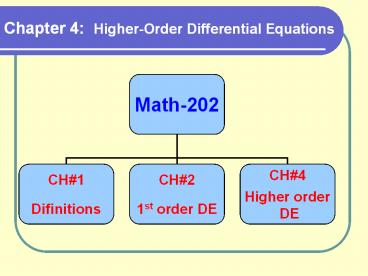Chapter%204:%20Higher-Order%20Differential%20Equations - PowerPoint PPT Presentation
Title:
Chapter%204:%20Higher-Order%20Differential%20Equations
Description:
Chapter 4: Higher-Order Differential Equations Math-202 CH#1 Difinitions CH#2 1st order DE CH#4 Higher order DE Chapter 4: Higher-Order Differential Equations Sec 4.1 ... – PowerPoint PPT presentation
Number of Views:940
Avg rating:3.0/5.0
Title: Chapter%204:%20Higher-Order%20Differential%20Equations
1
Chapter 4 Higher-Order Differential Equations
2
Chapter 4 Higher-Order Differential Equations
3
Sec 4.1 Linear DE (Basic Theory)
Sec 4.1.1 Initial Value Problem (IVP)
Boundary Value Problem (BVP)
IVP
. nth order linear DE
Theroem 4.1 ( Existence of a Unique Solution)
Sol y(x) Exist unique
4
Sec 4.1 Linear DE (Basic Theory)
Theroem 4.1 ( Existence of a Unique Solution)
Sol y(x) Exist unique
2
3
5
Sec 4.1 Linear DE (Basic Theory)
Theroem 4.1 ( Existence of a Unique Solution)
Sol y(x) Exist unique
Find an interval centered about x0 for which the
given IVP has a unique solution
9/p138
2
6
Sec 4.1 Linear DE (Basic Theory)
2ed order linear DE
Problem 1
Problem 2
What is the difference
IVP
BVP
7
Sec 4.1 Linear DE (Basic Theory)
2ed order linear DE
IVP
BVP
8
Sec 4.1 Linear DE (Basic Theory)
2ed order linear DE
IVP
BVP
Exist and unique When??
9
BVP can have many, one, or No sol
BVP3
BVP2
BVP1
Given that
2-parameter family of solutions
unique
No sol
Infinity number of sol
10
Sec 4.1.2 Homogeneous Equations
diff
homogeneous
nonhomogeneous
1
() is the associated homogeneous DE of ()
2
Remark before we solve (), we have to solve
first ()
11
Differential Operator
Differential Operators
12
Properties Differential Operator
Linear Operator
13
Quiz on Monday
2.1 3.1 4.1.1
14
DE ? Differential Operator Form
Write as DE
where
15
Homog DE
Theroem 4.2 ( Superposition Principle)
1)Constant multiple is sol 2)Sum of two sol is
also sol 3) Trivial sol is also a sol ??
are solutions
16
Homog DE
In general
Theroem 4.2 ( Superposition Principle)
17
Linear Dependence Linear Independence
Definition 4.1
IF
for every x in I
IF not then we say linearly independent
Note Linear Combination
Is this set linearly dependent ??
18
Linear Dependence Linear Independence
Definition 4.1
IF
for every x in I
IF not then we say linearly independent
Is this set linearly dependent ??
19
Linear Dependence Linear Independence
Definition 4.1
IF
for every x in I
IF not then we say linearly independent
Special case
If a set of two functions is lin. Dep, then one
function is simply a constant multiple of the
other.
Is this set linearly dependent ??
20
Linear Dependence Linear Independence
Definition 4.1
IF
for every x in I
IF not then we say linearly independent
Is this set linearly dependent ??
21
Linear Dependence Linear Independence
Definition 4.1
IF
for every x in I
IF not then we say linearly independent
Remark
A set of functions is linearly dependent if at
least one function can be expressed as a linear
combination of the remaining
Is this set linearly dependent ??
22
Homogeneous Equations
We are interested to find n linearly independent
solutions of the homog DE
homogeneous
23
Wronskian
Definition 4.2
called the Wronskian of the functions
Compute the Wroskian of these functions
Compute the Wroskian of these functions
24
Criterion for Linearly Independent Solutions
Theroem 4.3
Linearly Independent
These functions are solutions for the DE
lin. Indep ?
25
Fundamental set of solutions
Def 4.3
Fundamental set of solutions
These functions are solutions for the DE
Fund. Set of sol. ?
These functions are solutions for the DE
Fund. Set of sol. ?
26
General Solution for Homog. DE
Theorem 4.5
Is the general solution for the DE.
These functions are solutions for the DE
Find the general sol?
general sol means what??
Given is a sol for
27
How to solve Homog. DE
Given a homg DE
Step 1
Find n-lin. Indep solutions
Step 2
The general solution for the DE is































